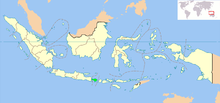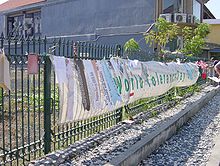Bali attack in 2002
The attack on Bali in 2002 on October 12 in the city of Kuta on the Indonesian island of Bali killed 202 people and injured over 209, some seriously. The Islamist-motivated bomb attack was the most momentous act of terrorism in Indonesian history to date . The victims were mostly foreign tourists, mostly Australians . Six Germans and three Swiss nationals, but also many locals, were among the dead.
The attack caused consternation and outrage around the world and had significant consequences for tourism on the popular holiday island. While around 5,000 tourists had previously visited Bali every day, this number fell by up to 80 percent after the terrorist attack.
Some Indonesians were later sentenced to death for their involvement in the act . In October 2002, Abu Bakar Bashir , the alleged founder and spiritual leader of the terrorist organization Jemaah Islamiyah , was on trial but was not found guilty of involvement in the attack until March 2005.
Background and course of events
The Hindu -influenced Bali is particularly popular with Australian tourists because of its geographical proximity. Surfers from many countries appreciate the island's southern coast to the Indian Ocean for good waves.
The target of the attack was suspected to be Australian tourists, who were viewed by Muslim extremists as the governor of the USA on behalf of their country of origin . Australia participated in the war on terror .
On Saturday, October 12, around 11:05 p.m. local time (3:05 p.m. UTC ), an electronically detonated bomb exploded in Paddy's Bar , probably hidden in a backpack. The bomb was small and effective and killed the backpack carrier, a suspected suicide bomber . The injured fled the bar into the street. About ten to fifteen seconds later, a second explosion took place in front of the Sari Club , which was triggered by a car bomb weighing almost 1 ton hidden in a white Mitsubishi van and detonated with a remote control .
Almost simultaneously, a bomb exploded in front of the US consulate in the island's capital Denpasar , but it only caused property damage. In Kuta there was a picture of destruction, injured and dead lay on the street, people ran around in panic and despair. The bomb shattered windows all over the city, leaving a crater almost five feet deep in the ground. The local hospital was unable to treat the many injured, most of them with burns . The Australian Air Force flew many seriously injured people to Darwin and other Australian cities.
The final number of victims was 202, mostly visitors to the two bars. Several hundred people suffered from burns and other injuries. The largest group of victims, with 88 people, were Australian vacationers. In addition, 38 Indonesian, 26 British, 7 American, 6 German, 5 Swedish, 4 Dutch, 4 French, 3 Swiss, 3 Danish and nationals of other western nations died. Three bodies remained unidentified and were cremated in September . The "Bali bombing" is sometimes seen as "Australia's September 11th " because of the high number of Australian fatalities and injuries.
Investigations and Suspects
Immediately after the attack, the Islamist organization Jemaah Islamiyah (JI) was held responsible for the crime, which was alleged to have links to the terrorist network Al-Qaeda . Investigators suspected C4 plastic explosives as a bomb material, but confirmed on October 21 that it was a mixture consisting mainly of easy-to-find ammonium nitrate .
Abu Bakar Bashir, an Islamic clergyman and presumed leader of Jemaah Islamiyah, denied any involvement at a press conference on October 12. In some statements, he blamed the US for building the bomb, claiming that it would not be possible for Indonesians to build such a sophisticated bomb.
Aris Munandar (or Sheik Aris ), a member of JI with ties to Bashir, allegedly assisted the prime suspect Amrozi bin Nurhasyim in obtaining the explosives and building the bombs. Filipino secret services suspect him to be a liaison to Mohammad Abdullah Sughayer, a Saudi Arabian national who is suspected of financing the Abu Sajaf Islamist terrorist group operating in the south of the Philippines .
The German citizen of Egyptian descent Reda Seyam is said to be the financier of the attack . He was questioned by the CIA in Indonesia about the assassination attempt , but was then transferred to Germany by the BKA to prevent him from being taken to a secret prison.
The Indonesian authorities arrested several alleged perpetrators in the course of the investigation, but suspected some were still at liberty. After the attack on the Marriott Hotel in the capital Jakarta on August 5, 2003, other suspects were arrested and charged with participating in the attack.
In March 2010, one of the alleged masterminds, the Indonesian Dulmatin near Jakarta, was killed in a shooting with security forces.
On January 25, 2011, the Pakistani authorities arrested Umar Patek , an alleged co-organizer, in Abbottabad . He was extradited to Indonesia on August 11th.
Convictions
In April 2003, Abu Bakar Bashir had to answer in court for high treason . He was accused of trying to overthrow the government and establish an Islamist state . The charges against him were mainly based on his involvement in a series of attacks on churches in the country during the 2002 Christmas season and on attempted attacks on Western facilities in Singapore . Initially, he was not on trial for the attack in Bali, although he was believed to be the instigator of the crime. On September 2, Bashir, who announced he would appeal the verdict, was acquitted of treason but sentenced to four years in prison for other offenses.
Just days later, on August 5, a car bomb exploded outside the JW Marriott Hotel in Jakarta, killing 12 people and injuring 149 people. As a result, Abu Bakar Bashir was arrested again on October 15, 2004. This time he was also charged with involvement in the bomb attack on October 12, 2002 in Bali and sentenced to two and a half years in prison.
On April 30, 2003, a court opened the trial against Amrozi bin Nurhasyim . He was charged with procuring the explosives and the pickup truck. The court sentenced Amrozi to death on August 8 . He accepted the judgment without remorse and with happiness. His older brother Ali Ghufron (also Mukhlas) received the death penalty on October 1, and the 33-year-old computer expert Imam Samudra on September 10. Amrozi's younger brother Ali Imron, a repentant teacher, was sentenced to life in prison on September 18 for his involvement.
The convicts claimed to have acted independently, but were assigned to the radical Islamist organization Jemaah Islamiyah . American terror experts assume that this organization is working with the Al-Qaeda network and that the autonomously working group is also supposed to be active in terrorism in neighboring countries.
The suspected bomb maker, the Malaysian Azahari bin Husin , died in November 2005 when he blew himself up in a house on the island of Java after the police had surrounded his house. Amrozi, Ghufron and Samudra were executed on November 9, 2008 on the prison island of Nusakambangan .
In June 2012, Umar Patek was sentenced to 20 years in prison by a Jakarta district court for aiding and abetting the Bali attacks. He was also convicted of aiding and abetting bomb attacks on churches in Jakarta on Christmas 2000, in which 19 people were killed. After an extenuating admission, the court found that Patek had assembled the bombs for the attacks.
See also
- Attack on the Marriott Hotel in Jakarta
- Terrorist attack on the Australian embassy in Jakarta
- 2005 Bali attack
- Attacks in Jakarta on January 14, 2016
Web links
Individual evidence
- ↑ DPA - AFX: Tourist exodus from Bali after attacks have not yet occurred . October 3, 2005 (accessed via LexisNexis Wirtschaft ).
- ↑ Jochen Bittner : " Hunting among friends ". In: Die Zeit No. 52 of December 21, 2005
- ↑ Bali bomber dies in an exchange of fire with the police In: Der Stern from March 10, 2010
- ↑ Umar Patek's trial seemingly goes nowhere. In: The Jakarta Post . March 20, 2012, accessed June 23, 2012 .
- ↑ Bali assassin extradited. In: ORF . August 11, 2011, accessed August 11, 2011 .
- ↑ Al- Qaida attack: 20 years imprisonment for bomb builders in Bali at Spiegel Online , June 21, 2012 (accessed June 21, 2012).
Coordinates: 8 ° 43 ′ 2 ″ S , 115 ° 10 ′ 27 ″ E




